
Sheep Terminology 101
If you want to raise sheep or own them as pets, it’s a good idea to have an understanding of sheep terminology. Not only can this help you when it comes to purchasing sheep but also as you care for them and manage your flock. In this article, I discuss sheep. terminology in six different sections: anatomy, behavior, care, medical, farming, and breeding. Let’s go ahead and get started!
Sheep Anatomy Terminology
This section will share terminology relating to sheep anatomy, including proper gender terms and specific body parts. Knowing your sheep anatomy can help you sound like a seasoned and experienced sheepherder!
Buck: a slang term for an intact male sheep.
Ewe: a female sheep. To know more about ewes, read my article What a Female Sheep Is Called & Interesting Female Sheep Facts.
Ewe Lamb: a female lamb. This term is usually used to refer to a female sheep under the age of one year old.
Fleece: the wool coat that certain sheep breeds grow.
Hogg Sheep: a sheep over the age of one year old that has yet to be sheared. This term can be used to refer to both male and female sheep.
Horns: a bony growth that protrudes from either side of the sheep’s poll, or forehead. Not all sheep have horns. In certain sheep breeds, neither male nor female will have horns while in other breeds, just the males will have horns. There are also breeds where the males and females both grow horns.
Lamb: a sheep under the age of one year old. Read more about lambs in my article Baby Sheep: What a Baby Sheep Is Called & Other Fun Facts.
Lanolin: an oil that sheep naturally produce. This oil covers the sheep’s wool and skin and naturally repels water. When wool is removed from the sheep, it must be treated with heat to remove the lanolin from the fleece.
Monocular Vision: the type of vision that sheep and most prey animals have. Sheep have eyes on the side of their head so that they can see almost 360° around them. This helps them to watch for danger and be more aware of their surroundings.
Ovine: used to describe sheep-like characteristics or anything that may relate to sheep. The genus of mammals that sheep fall under is known as Ovis.
Ram: an intact male sheep that has the ability to reproduce.
Ram Lamb: a male lamb. This term is usually used to refer to male sheep under the age of one year old.
Rumen: the first part of the sheep’s stomach that partially digests food before passing it on to other areas of the stomach. A sheep has one stomach with four different sections; the rumen is one section of the stomach.
Ruminant: animals that regurgitate food from their rumen to re-chew it so that they can extract more nutrients from it and digest it more thoroughly. This is known as “chewing the cud.”
Udder: the mammary gland of the sheep located between the two hind legs. The udder will usually have four teats where the lamb can draw milk from.
Wether: a castrated male sheep. To learn more about wether sheep, visit my article Wether Sheep: Definition of Wether Sheep & Unique Traits
Withers: the point of the sheep’s back that is usually the tallest. This is right above the shoulders and is the area usually used to measure the sheep’s height.
Wool: a thick waterproof coat grown by certain sheep breeds. Wool can be harvested and turned into yarn and clothing products.
Yearling: a sheep between the ages of one and two years old.
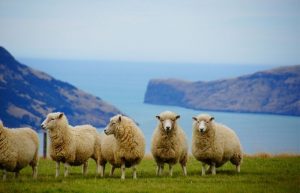
Sheep Behavior Terminology
Like any animal, sheep have unique ways of communicating and behaving. Understanding the different ways sheep behave can help you recognize when they seem off or when they require attention. Here’s what you need to know:
Bleat: a vocalization made by sheep that sounds like “baaa.” Sheep may bleat for numerous reasons like is they are trying to locate other sheep or they are anxious. They may also bleat if they are underfed or hungry. You can learn more about why sheep bleat by reading my article Why Sheep Bleat: Essential Behavior Guide.
Browse: twigs, leaves, weeds, and shrubs that sheep intentionally seek out to eat. While sheep are usually grazers who can eat grass for hours at a time, they also like to treat themselves to browse plants.
Cast: when a sheep can not get up from lying down. These sheep are usually old, pregnant, or are weighed down by wool. If the sheep is down for too long, gasses can build up in its systems, it can become dehydrated, and the sheep can eventually die. If a sheep is cast, it will need help to get back on its feet before it’s too late.
Charging: an act of defense and aggression that sheep show each other, other animals, and even humans. Charging is when a sheep lowers its head and runs at its enemy to headbutt them.
Flock: a group of usually more than five sheep; a community of sheep that provides security and protection from predators and other threats.
Graze: eating grass and vegetation for a long period of time. Sheep are natural grazers. While it may seem like grazing animals consume a lot of food, it’s essential for them to do in order to get all the nutrients they need to survive.
Gregarious: animals that live in social communities. Sheep are gregarious by nature since they live in a flock.
Head-Butting: an act of defense or aggression that sheep use. Sheep will lower their head and ram the top of their head against the object or animal they are trying to ward off.
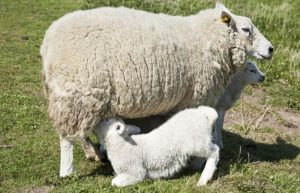
Sheep Care Terminology:
While sheep are known to be low-maintenance livestock, they do require care and specific attention depending on the situation. Here are some terms you should know when it comes to caring for sheep:
Bottle Lamb: a lamb that is reliant on being bottle-fed rather than nursing its mother. Often times, these lambs have been rejected by their mothers or the mother is sick and has died. Lambs may also need to be bottle-fed if they are too weak to nurse.
Brood Ewe: a ewe that is used for breeding purposes
Bummer: a lamb that has been rejected by its mother. In these cases, the ewe lamb will usually refuse to nurse its lamb and may even ignore it completely.
Cud: partially digested food that is regurgitated from the rumen of the sheep. The sheep will re-chew the food to extract more nutrients and to make the food more digestible.
Culling: determining which ewes will not be used for breeding for the next season. Can also refer to selling off sheep in your flock that aren’t productive anymore.
Cull Yow: a female sheep that is too old to be bred and reproduce. While sheep can reproduce well into seniority, the sheep can have more risks the older they are. For this reason, farmers will usually stop breeding sheep that are 7 – 8 years of age.
Graft: when a lamb will be raised by a sheep that isn’t its mother. This is done if the mother rejected the lamb, died, or is unable to provide milk.
Guardian Animal: an animal that guards and protects sheep from predators and other threats. Dogs, donkeys, and llamas make great guardian animals for sheep. To learn more about livestock guardian animals, read my article What Are the Best Livestock Guardian Animals?
Hand-Rearing: when a lamb is raised by humans rather than its sheep mother. These lambs usually require extra attention because they are sick and weak or because they were rejected or orphaned by their mother.
Jug: a small pen that sick sheep or a mother and its lamb can be placed in so that they are separate from the flock but can still see other sheep.
Shear: the act of removing a sheep’s wool fleece. This is usually done once a year in the Springtime to harvest the wool and to maintain the sheep’s hygiene.
Sheepfold: a pen for a flock of sheep that can provide protection and security for the entire flock.
Skirting: the process of removing dirty and less desirable wool from wool that has just been removed from the sheep. Wool from the sheep’s belly and the backside is less desirable since these areas are damaged by mud and feces.
Wigging: clipping the wool around the sheep’s eyes so the sheep’s vision is not obstructed.
Wool-Blindness: when sheep are unable to see because the wool around their eyes has become overgrown and shields their vision.
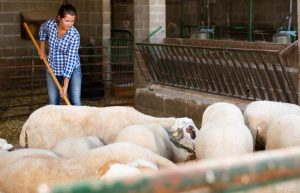
Sheep Medical Terminology
In this section, I’m going to share some medical terms specific to sheep, from sheep procedures and events to certain illnesses or infections sheep may deal with.
Banding: a method of tail docking and castrating lambs. In this method, a tight rubber band is placed around the lamb’s tail or scrotum to cut off the blood supply. The tail and testes will eventually die and fall off. This is considered a bloodless way to dock or castrate a lamb.
Burdizzo: a clamping tool used to castrate lambs.
Castrate: a procedure that makes male lambs unable to reproduce.
Colostrum: milk produced by a ewe in the first few hours after the ewe has given birth. Colostrum has vital antibodies, nutrients, and vitamins that can help the lamb build its immune system and avoid disease. Colostrum intake can help the lamb survive its first few weeks of life, which is when they are the most susceptible.
Dag: feces that are caught in the sheep’s wool around their backside. Many farmers will shear the wool around the sheep’s rear end to help solve this problem and to practice good hygiene habits.
Dock: a procedure where the tail of the sheep is removed. Lambs that will grow thick wool coats usually have long woolly tails that can cause feces to get spread and caught in their fleece. Docking the tail can help maintain the sheep’s hygiene. Lambs will usually have their tails docked before 12 weeks of age.
Elastrator: the tool used to apply rubber bands in the banding process used either for docking or castration.
Estrus Cycle: the reproductive cycle of sheep. Female sheep will come into estrus or heat every 16-17 days, where they will be able to get pregnant if bred.
Fly Strike: when flies lay eggs in the sheep’s wool. Fly strike is usually caused by dag in the sheep’s fleece that attract the flies to nest and lay eggs.
Foot Rot: a contagious bacterial infection of the sheep’s hoof that eats away and compromises the structure of the hoof, which can lead to severe lameness in the sheep.
Gestation: the period of time a sheep is pregnant. The average gestation period for sheep is 145 – 150 days.
Hoof Shears: a tool used to trim a sheep’s hooves. Sheep need their hooves trimmed every 6 – 10 weeks.
Joining: when a ram is allowed to join a flock of ewes for mating. Breeding season for sheep is usually October or November, so the ram will be placed in with the ewes then.
Lambing: the process of a ewe giving birth to a lamb.
Scab: a bacterial infection that affects the sheep’s skin. The skin of the lamb will be irritated and scabbed over, causing the sheep discomfort and pain. Scab can happen moisture is held to the sheep’s skin for too long. To learn more about how moisture can affect sheep, check out my article Leaving Sheep Out in the Rain: Everything You Need to Know.
Tupping: the sheep mating season, which usually happens in late Autumn.
Weaning: the process of separating a lamb from its mother so it can learn to be reliant on other food sources other than its mother’s milk. Lambs can be weaned as early as 60 days old, as the mother’s milk production will have started to decrease at this point.
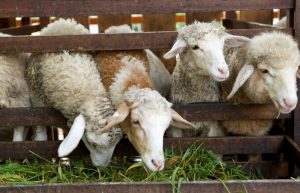
Sheep Farming Terminology
When it comes to raising sheep, there are some terms that can help you provide better flock management and care. There are also terms that relate to specific industries, like wool, meat, or breeding. Here’s what you need to know:
Band: a large flock of sheep; bands can have as many as 1,000 sheep! Bands are usually only seen for the commercial production of wool or meat.
Creep Grazing: when certain are allowed to graze pasture ahead of other sheep. This enables the first group of sheep to get more high-quality forage, which can help them gain weight.
Dam: a female sheep that has given birth to a lamb; this term is used to describe the ewe as a mother.
Driving: when you lead from one place to another.
Forage: vegetation that is heavily relied on for the sheep’s diet. Forage usually refers to grass or legumes that sheep eat in large quantities to sustain their diet.
Lamb: the meat produced by sheep younger than one year of age.
Mob Grazing: when a large number of sheep is set to graze a small area for a short period of time before moving on to the nest area. This ensures the sheep get quality forage but also lets the land rest from the stress of being grazed.
Mutton: meat produced by a sheep over one year of age.
Rotational Grazing: when sheep are moved from one pasture to another to allow the previous pastures to rest and grow quality forage.
Shepherd: someone who tends to and takes care of sheep.
Sire: a male sheep that has produced lambs; this term is used to describe the ram as a father.
Strip Grazing: when sheep are allowed to graze pasture sections at a time. Once one section has been grazed, another section will open up.
Sucker: lambs dependant on their mother’s milk.
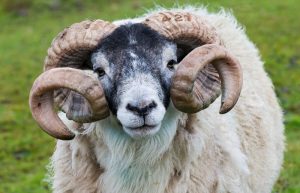
Sheep Breed Terminology
Did you know that there are terms specific to certain sheep breeds? Different sheep breeds each have their own unique characteristics. This can help you when it comes time to finding the right sheep for your operation.
Blackfaced: A sheep that has a black face while their wool is white. While this characteristic can be seen in any sheep, there are certain breeds that are blackfaced. Such breeds include Suffolk Sheep, Hampshire Sheep, and Scottish Blackface Sheep.
Closed Flock: a flock that has not had any new members introduced. This can help ensure health qualities in lambs born to the flock.
Crossbreeding: when two different sheep breeds are bred together.
Downs: Sheep that grow a shorter wool fleece. Hampshire Down Sheep, Oxford Down Sheep, and Dorset Down Sheep all have this characteristic.
Hair Sheep: sheep that grow a coat of hair rather than fleece. Hair sheep breeds include Dorper Sheep, Royal White Sheep, St. Croix Sheep, and Wiltshire Horn Sheep.
Horned Sheep: sheep that grow horns. Some sheep breeds that grow horns include Dorset Horn Sheep, Jacob Sheep, Manx Laoghtan, and Norfolk Horn Sheep.
Mule: a sheep that is the result of crossbreeding. This sheep will be a mix of two different sheep breeds.
Polled Sheep: Sheep that do not naturally have horns. Here are some polled sheep breeds: Poll Dorset, Border Leicester, White Suffolk Sheep, and Babydoll Sheep. (To learn more about Babydoll Sheep, check out my article How Big Do Babydoll Sheep Get? What You Need to Know.)
Purebred: a sheep born of two sheep from the same breed.
Wool Sheep: sheep that grow the stereotypical thick wool fleece as their coat. Wool sheep breeds include Southdown Sheep, Suffolk Sheep, Border Leicester, Merino, and Romney Sheep.
Did you know that we have many articles about farm animals other than sheep? If you’re interested in expanding your farm family, you should take the time to learn about different livestock and how to care for them. To read more of our articles, click here!
